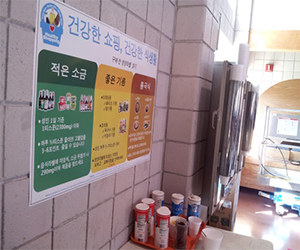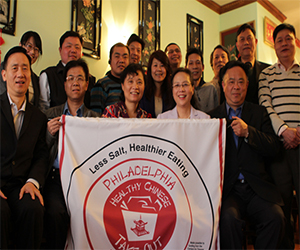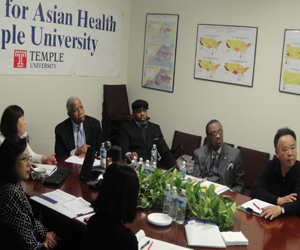CVDs and Chronic Disease Research
In its effort to reduce or eliminate health disparities in Asian Americans, the Center initiated research in CVDs and chronic diseases that are more prevalent in under-served and under-insured populations, including Asians Americans. Cardiovascular disease is the final common pathway from metabolic syndrome, peripheral vascular disease and chronic renal disease. Risk factors for the disease include, among other, hypertension, smoking, obesity, inactivity, psychosocial factors (e.g., stress), and heredity. Treatment options include exercise, weight management, dietary modifications, blood pressure management, lipid management, and psychosocial screening. The first phase of the Center research has targeted two significant risk factors: hypertension management and diabetes management.
A second chronic disease identified by the Center is osteoporosis. Osteoporosis is loss of bone density that leads to fractures and breaking of bones. While the disease affects more women than men, both men and women are equally affected by it in old age. Genes, age, and lifestyle are factors that predict onset and progression of the disease. Although treatable, osteoporosis is not curable, hence the important of timely intervention, particularly at a young age.
The vulnerability of Asian Americans to the disease may be attributed to a number of factors among which are: lack of awareness of and knowledge about the disease, the absence of disease symptoms, and lack of adequate healthcare. Center research is focusing on culturally and linguistically appropriate and feasible approaches to early prevention and management of the diseases.
Jump to research about:
- IDEAL Program
- Healthy Chinese Take-Out Initiative
- Salt Reduction - African Americans
- Metabolic Syndrome - Asian Americans
- Diabetes Risk Factors - Chinese Americans
- SPRINT
IDEAL Program: Improving Diets with an Ecological Approach for Lifestyle to Prevent Chronic Diseases
(U58, PI: Grace Ma, PhD, funded by Centers for Disease Control and Prevention)
 Recent data indicates that increases in diabetes, hypertension, coronary heart disease (CHD) and stroke present new threats to health. Asian Americans (AA) are 60% more likely to have diabetes than non-Hispanic whites when data is adjusted for age, sex, and BMI, despite many undiagnosed cases. AAs suffer higher rates of hypertension ranging from 40% to 69% and the uncontrolled hypertension rate is significantly higher in AAs as compared to Caucasians. Heart disease is the second leading cause of death among AAs who have high rates of chronic
Recent data indicates that increases in diabetes, hypertension, coronary heart disease (CHD) and stroke present new threats to health. Asian Americans (AA) are 60% more likely to have diabetes than non-Hispanic whites when data is adjusted for age, sex, and BMI, despite many undiagnosed cases. AAs suffer higher rates of hypertension ranging from 40% to 69% and the uncontrolled hypertension rate is significantly higher in AAs as compared to Caucasians. Heart disease is the second leading cause of death among AAs who have high rates of chronic  obstructive pulmonary disease.
obstructive pulmonary disease.
Certain diet habits, such as unhealthy oil used in cooking, high sodium sauces and salt in traditional food, increased use of white rice and white flour/rice noodles are the main nutrition problems among Asian Americans. The primary risk factors for these diseases are modifiable such as diet, a unique opportunity can potentially reverse these trends.
 We use multilingual graphically enhanced intervention to improve the knowledge of US Nutrition Guidelines and Fact Labels, as well as increase accessibility and availability to healthy food options for the diverse limited English proficient Asian Americans. This project is led by Center for Asian Health (CAH), Temple University in partnership with Asian Community Health Coalition, Philadelphia Department of Public Health, Greater Philadelphia Chinese Restaurant Association, Asian CBOs, Asian supermarkets, and local Asian media groups.
We use multilingual graphically enhanced intervention to improve the knowledge of US Nutrition Guidelines and Fact Labels, as well as increase accessibility and availability to healthy food options for the diverse limited English proficient Asian Americans. This project is led by Center for Asian Health (CAH), Temple University in partnership with Asian Community Health Coalition, Philadelphia Department of Public Health, Greater Philadelphia Chinese Restaurant Association, Asian CBOs, Asian supermarkets, and local Asian media groups.
Philadelphia Healthy Chinese Take-out Initiative (HCTI)
(PI: Grace Ma, PhD, funded by Centers for Disease Control and Prevention & Philadelphia Department of Public Health)
 Currently in the United States, most Americans consume over 3,400 milligrams of sodium daily, well above the 2015 Dietary Guidelines for Americans recommendation of less than 2,300 milligrams per day. Overwhelming evidence demonstrates the strong relationship between excessive sodium consumption and a range of health problems including high blood pressure, cardiovascular disease, stroke, gastric cancer, and kidney stones. Among U.S. adults, over 400,000 deaths annually can be attributed to elevated blood pressure and excess dietary sodium.
Currently in the United States, most Americans consume over 3,400 milligrams of sodium daily, well above the 2015 Dietary Guidelines for Americans recommendation of less than 2,300 milligrams per day. Overwhelming evidence demonstrates the strong relationship between excessive sodium consumption and a range of health problems including high blood pressure, cardiovascular disease, stroke, gastric cancer, and kidney stones. Among U.S. adults, over 400,000 deaths annually can be attributed to elevated blood pressure and excess dietary sodium.
Philadelphia has the highest prevalence of hypertension among the 10 largest U.S. cities, affecting 48 percent of African Americans and 32 percent of Hispanics. Chinese take-out restaurants, a ubiquitous part of the Philadelphia landscape, are located predominantly in low-income neighborhoods with large racial/ethnic minority populations. There are more than 480 independently owned and operated Chinese take-out restaurants in Philadelphia, serving 6 million customers annually.  This is three times more than the number of McDonald’s, Wendy’s, Burger King, Pizza Hut and KFC restaurants in Philadelphia combined. Chinese take-out food is typically very high in sodium. Given that nearly half (47%) of Americans are dining out more than three times per week on these sodium laden meals, sodium reduction interventions targeting the Chinese take-out restaurants created an opportunity to promote salt reduction in high risk Philadelphia community neighborhoods.
This is three times more than the number of McDonald’s, Wendy’s, Burger King, Pizza Hut and KFC restaurants in Philadelphia combined. Chinese take-out food is typically very high in sodium. Given that nearly half (47%) of Americans are dining out more than three times per week on these sodium laden meals, sodium reduction interventions targeting the Chinese take-out restaurants created an opportunity to promote salt reduction in high risk Philadelphia community neighborhoods.
HCTI has been working with over 220 local restaurant owners and chefs to reduce the sodium content in their meals. This effort is a partnership between Temple University’s Center for Asian Health, the Asian Community Health Coalition (ACHC), the Greater Philadelphia Chinese Restaurant Association (GPCRA), and the Philadelphia Department of Public Health. This brief presents evaluation data related to the implementation of the Healthy Chinese Take-Out Initiative.
Key components included: 1) a formative assessment of owner/chef knowledge, attitudes, and behaviors related to salt use and consumption, 2) culinary expert-led low sodium cooking training, 3) distribution of low sodium cooking materials including low sodium recipes, toolkits, and measuring spoons, and 4) on-site compliance checks and booster trainings. Program staff also conducted customer taste tests, and the sodium content of meals was randomly collected and assessed at baseline and at 6, 24 and 36 months post training interventions.
of owner/chef knowledge, attitudes, and behaviors related to salt use and consumption, 2) culinary expert-led low sodium cooking training, 3) distribution of low sodium cooking materials including low sodium recipes, toolkits, and measuring spoons, and 4) on-site compliance checks and booster trainings. Program staff also conducted customer taste tests, and the sodium content of meals was randomly collected and assessed at baseline and at 6, 24 and 36 months post training interventions.
This unique initiative - to our knowledge, the only one of its kind in the U.S. to focus on Chinese take-outs - sets a precedent and develops a model for other independent restaurants to gradually lower the high sodium content in restaurant foods nationally.
Learn more about the Philadelphia Healthy Chinese Take-out Initiative (HCTI).
Salt Reduction for High-Risk African Americans to Prevent Hypertension in Philadelphia Communities
(Temple U PI: Grace Ma, PhD, funded by Centers for Disease Control and Prevention & Philadelphia Department of Public Health)
 Philadelphia has an urgent need to reduce sodium consumption and prevent hypertension among its residents. Americans consume twice the recommended sodium intake. 77% of the dietary sodium that Americans consume comes from processed and restaurant foods. Over consumption of sodium has been shown to have a strong relationship with hypertension.
Philadelphia has an urgent need to reduce sodium consumption and prevent hypertension among its residents. Americans consume twice the recommended sodium intake. 77% of the dietary sodium that Americans consume comes from processed and restaurant foods. Over consumption of sodium has been shown to have a strong relationship with hypertension.
Philadelphia Department of Public Health data indicate that African Americans who live in low income high poverty areas have a high prevalence of hypertension where nearly 47.1% of them having high blood pressure. For African Americans, not only is their high blood pressure more prevalent, but also it develops earlier in life. Timely interventions focused on limiting sodium intake can effectively reduce the incidence of hypertension and other diseases. Reducing sodium intake can help decrease blood pressure, and prevent the occurrence of cardiovascular diseases, such as heart attack and stroke.
 The trusted faith-based organization leaders are important change agents in African American communities and neighborhoods. By working with church pastors and clergies in targeted high poverty area across the city, we can make positive lifestyle changes to impact the overall health of the neighborhoods. As part of the program strategies, we engaged pastors in nutrition program development and education delivery and healthy diet role modeling.
The trusted faith-based organization leaders are important change agents in African American communities and neighborhoods. By working with church pastors and clergies in targeted high poverty area across the city, we can make positive lifestyle changes to impact the overall health of the neighborhoods. As part of the program strategies, we engaged pastors in nutrition program development and education delivery and healthy diet role modeling.
By sharing healthy sodium facts, healthy recipes and community taste events in collaborative faith based organizations, we have increased sodium reduction awareness among church pastors and members and change their sodium consumption behavior to protect them from heart attacks and strokes.
Prevalence, Risk Factors, and Components Patterns of Metabolic Syndrome in Asian Americans
(PI: Lin Zhu, PhD; Co-I: Grace X. Ma, PhD, funded by American Heart Association)
Metabolic Syndrome (MetS) is a disease entity characterized by a constellation of interconnected physiological, biochemical, clinical, and metabolic factors that directly increase the risk of cardiovascular diseases and type 2 diabetes. Limited evidence of MetS found that despite lower body mass index (BMI), Asian Americans have higher MetS rate than Caucasians at each level of BMI. Furthermore, there persists little consensus about which metabolic components constitutes essential features, or about whether insulin resistance (IR) or abdominal obesity is the unifying underlying abnormality. Even more scant is literature on Asian Americans, a group with distinct physiological features such as body habitus, lipid metabolism, or insulin sensitivity from other racial/ethnic groups. This proposed study seeks to expand our currently limited understanding on MetS in Asian Americans, and by doing so, generate epidemiological data and policy implications for health professional and stakeholders. The proposed study will use the data the non-Hispanic Asian samples from the National Health and Nutrition Examination Survey (NHANES) from 2011 to 2016.
Diabetes Risk Factors Among Chinese Americans
(R01, PIs: Carolyn Fang, PhD and Marilyn Tseng, PhD, funded by the National Institute of Diabetes and Digestive and Kidney Diseases, NIH)
Chinese Americans represent the largest subgroup of Asian Americans. Despite relatively low prevalence of obesity in Chinese Americans, rates of type 2 diabetes in Chinese Americans are converging with, and sometimes even exceed, rates in the US white population.
Thus, we are conducting a longitudinal study of Chinese American men and women to identify key behavioral, sociocultural, and biologic factors associated with increased diabetes risk in this relatively non-obese population. Findings from this study will test the hypothesis that behavioral and social factors are associated with diabetes risk markers via inflammatory pathways.
Ultimately, this information will be used to identify key pathways contributing to disease risk and guide the development of novel strategies for early intervention and prevention in future studies.
The Systolic Blood Pressure Intervention Trial (SPRINT)
(UL1, Site PI, Crystal A. Gadegbeku MD and co-PI Avrum Gillespie, funded by NHLBI, NIDDK, NIA, NINDS)
Hypertension is highly prevalent in the U.S. and affects 1 billion adults worldwide. This NIH-funded multi-site study was conducted to determine whether a lower systolic blood pressure of < 120 mmHg would reduce risk for cardiovascular events compared to the standard goal of < 140 mmHg in patients with high blood pressure and other cardiovascular risk factors. A diverse ethnic population of 9,361 adults over age 50 with hypertension and increased cardiovascular risk were randomly assigned to a blood pressure target of < 120 (intensive) or < 140 (standard) with hypertension medications. SPRINT also included a group of individuals over age 75 and a group with chronic kidney disease but excluded patients with diabetes.
Participants were monitored for cardiovascular events as well as serious adverse events including hypotension, fainting, kidney failure, and falls. The study was stopped early at a median follow-up of 3.26 years due to a 25% reduction in composite outcomes and a 27% in all-cause mortality in the intensive blood pressure group. This study may lead to redefining blood pressure goals in certain populations and highlights the importance of blood pressure management.
